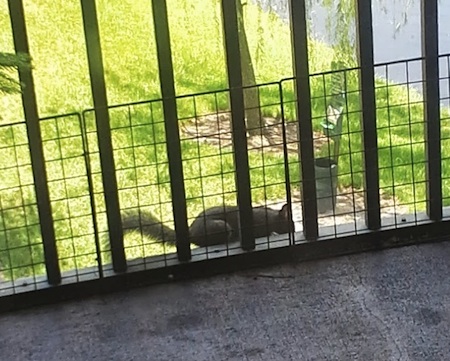Who knows what evil lurks in the hearts of men rabbits?
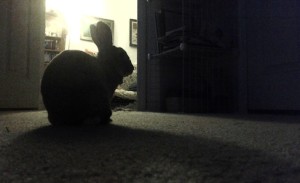
The shadow bunny knows!
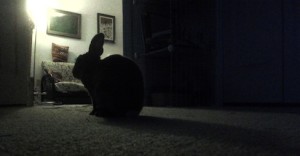
Noe keeps watch in case a thief tries to swipe her yummy fresh hay from the closet.
(Photos: Y. Fernandez)
I’ve recently had a proposal accepted to present some research at the upcoming American Geophysical Union conference. I have to say that I never really pictured myself presenting at an AGU meeting, what with not being a geologist and all 🙂 But since I’m working on the communication of sea level rise, it’s actually a good fit for this project. At any rate, I think it’ll be an interesting presentation. Here’s the abstract; my coauthors are Denise DeLorme (UCF-Communication) and Scott Hagen (UCF-Civil, Envtl. & Construction Engineering):
Building Stories about Sea Level Rise through Interactive Visualizations
Digital media provide storytellers with dynamic new tools for communicating about scientific issues via interactive narrative visualizations. While traditional storytelling uses plot, characterization, and point of view to engage audiences with underlying themes and messages, interactive visualizations can be described as “narrative builders” that promote insight through the process of discovery (Dove, G. & Jones, S. 2012, Proc. IHCI 2012). Narrative visualizations are used in online journalism to tell complex stories that allow readers to select aspects of datasets to explore and construct alternative interpretations of information (Segel, E. & Heer, J. 2010, IEEE Trans. Vis. Comp. Graph.16, 1139), thus enabling them to participate in the story-building process. Nevertheless, narrative visualizations also incorporate author-selected narrative elements that help guide and constrain the overall themes and messaging of the visualization (Hullman, J. & Diakopoulos, N. 2011, IEEE Trans. Vis. Comp. Graph. 17, 2231).
One specific type of interactive narrative visualization that is used for science communication is the sea level rise (SLR) viewer. SLR viewers generally consist of a base map, upon which projections of sea level rise scenarios can be layered, and various controls for changing the viewpoint and scenario parameters. They are used to communicate the results of scientific modeling and help readers visualize the potential impacts of SLR on the coastal zone. Readers can use SLR viewers to construct personal narratives of the effects of SLR under different scenarios in locations that are important to them, thus extending the potential reach and impact of scientific research. With careful selection of narrative elements that guide reader interpretation, the communicative aspects of these visualizations may be made more effective.
This presentation reports the results of a content analysis of a subset of existing SLR viewers selected in order to comprehensively identify and characterize the narrative elements that contribute to this storytelling medium. The results describe four layers of narrative elements in these viewers: data, visual representations, annotations, and interactivity; and explain the ways in which these elements are used to communicate about SLR. Most existing SLR viewers have been designed with attention to technical usability; however, careful design of narrative elements could increase their overall effectiveness as story-building tools. The analysis concludes with recommendations for narrative elements that should be considered when designing new SLR viewers, and offers suggestions for integrating these components to balance author-driven and reader-driven design features for more effective messaging.
I’ll also be presenting a poster at the upcoming Sea Level Rise Summit, related to a major research project that the CHAMPS Lab is currently involved in. My coauthors are Scott Hagen and the EESLR-NGOM team. My role here will be to describe the unique aspects of this project, which I’ve recently become involved in:
The Coastal Dynamics of Sea Level Rise: A Case Study Approach
This presentation describes the Ecological Effects of Sea Level Rise-Northern Gulf of Mexico (EESLR-NGOM) project, an integrated field observation and modeling study that will predict how sea level rise (SLR) interacts with coastal hydrology to affect different marsh and coastal species. This multidisciplinary project builds on lab and field experiments and observations to inform a suite of predictive computer models. The project combines models of water circulation, overland flow, coastal hydrodynamics, and sediment transport. Models and ground-based assessments will provide forecasts of intertidal marsh evolution and inform marsh, seagrass, and oyster habitat models. The ultimate predictions will include the impact of SLR on intertidal marshes, oysters, and submerged aquatic vegetation at the three National Estuarine Research Reserves (NERRs). Science team members are working with coastal resource managers to ensure that project results and decision support tool products are useful to them. Partners include: Univ. of Central Florida; Florida State Univ.; Univ. of South Carolina; Apalachicola, Grand Bay and Weeks Bay NERRs; and Dewberry.
On a work-related trip to Alabama this summer, I stayed overnight in the town of Fairhope, on Mobile Bay. I took a short walk around town to the Fairhope pier, which has a set of purple martin houses set around it in the water.
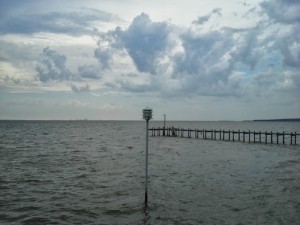
Purple martins nest in holes in trees, but are having real problems competing with European starlings for nest sites. As a result, they do best in artificial nest boxes like the ones in Fairhope which people help keep starlings away from. As far as I know, there’s only one purple martin colony in the Eastern US that uses natural trees to nest in anymore, and that one is in the Orlando Wetlands Park.
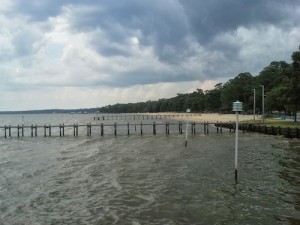
Fairhope sits on bluffs above the bay, and it’s always nice to see some coastal topography, coming from Florida. Rain was moving in across the bay-an afternoon thunderstorm, which was pretty Florida-like-so I didn’t stay long at the pier. I headed back uphill to the hotel, walking through a park on the way.
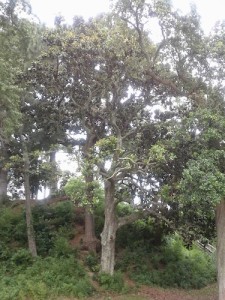
Bluffs or no, the park was covered with pine woods that seemed fairly Florida-like. In fact, they are a remnant longleaf pine forest, which once covered a large part of the coastal SE US, including central Florida. Unfortunately, the longleaf ecosystem has been pretty impacted by human development; what’s more, this ecosystem is fire-dependent. It’s hard to say what will happen to the longleafs of Fairhope, since it’s unlikely that the town will be willing to manage the habitat with controlled burning right on the edge of town
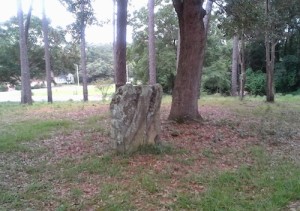
So I got back to the hotel before rain started to fall. Martins and pine woods are nice any day, so I enjoyed my stroll in Alabama.
Twice a year, Noe goes through a big shedding cycle, in early spring and late summer. This is one thing that’s different for a rabbit than for a dog or cat: rabbits have fur, rather than hair- which is defined by whether they shed all the time or at seasonal times.
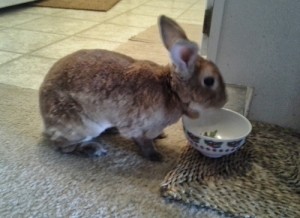
Because we’d never had a rabbit before, it definitely took some getting used to seeing one layer of her fur come completely out, new fur start to grow in, and then the second layer come out. The weird thing is that her fur comes out in patches: typically starting at the head and neck and then working its way back. When both layers are growing back in at the same time, she looks really odd- not actually bald, but more like she’s had a haircut.
Anyway, she’s partly through her shed now, and looks pretty ragged. Doesn’t influence her love of arugula, though!
Towards the end of May, I made a visit to Minnesota. It was a pretty good time to visit: the weather was getting warm but it was still nice and cool compared to Orlando.
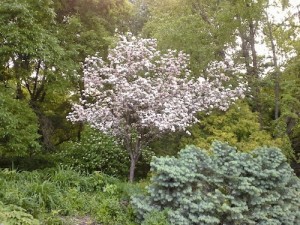
I spent some time with my dad while he did some printmaking, and then dragged him out on a birding field trip to the Minnesota River Valley. Which he did seem to enjoy- though he volunteered to carry a spotting scope for an older birder and ended up carrying it around for several miles. (Sorry, Dad.)
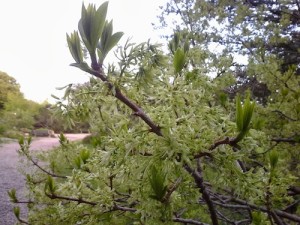
We also took an evening stroll to the gardens around Lake Harriett, in Minneapolis. I can’t identify many of the plants, but they were quite pretty.
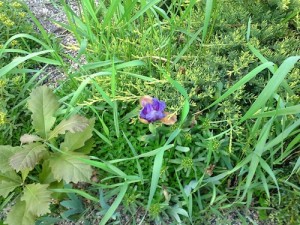
As the sun was setting, we saw several common nighthawks fly by, making their peent! call. It’s always interesting to see relatively big birds in urban areas. Who knows-maybe they’re nighthawks that winter in Florida, and they’re migrating south now. I’ll often see nighthawks near the UCF campus observatory in the evenings.
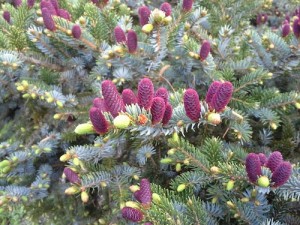
The common nighthawk is the American Birding Association bird of the year for 2013. They’re pretty cool birds, though their numbers are declining. I hope the birds we saw in May were having a nice early summer evening catching bugs, and that they did well over the summer and are now ready to head south.
More Noe and her blue ice!
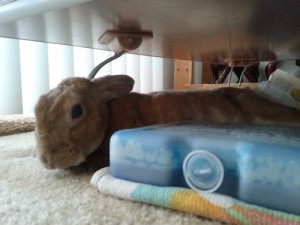
Nap time is all very good and well, but eventually a rabbit gets thirsty.
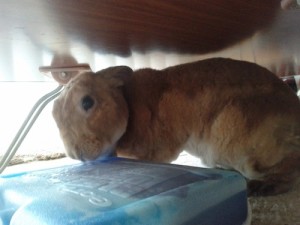
Yes, she does get water in a more normal way, but this is apparently much more fun.
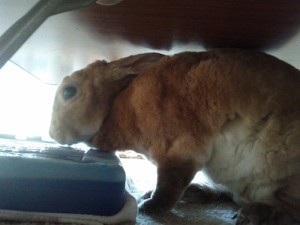
She can’t possibly get a lot at one time, but maybe it makes a nice refreshing break.
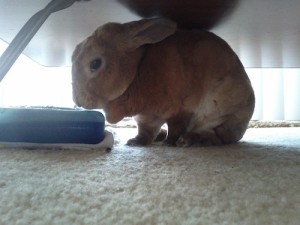
Of course, drinking is hard work. Luckily, she can lean on the blue ice to cool off.
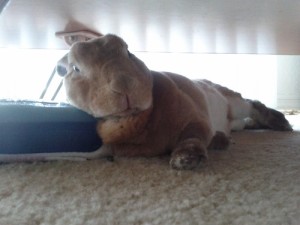
…and then round two of napping can begin.
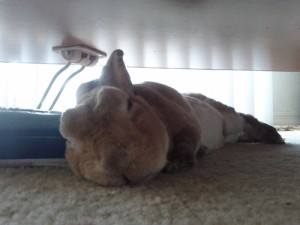
Waaay back in May, we took a hike in the Split Oak Forest Wildlife and Environmental Area. (A tongue-tying name, to be sure.) This area is accessed through Moss Park. While Moss Park is just south of the 417, we’d only made it there once before, and were chased away by a summer thunderstorm. On the day we took this hike, the weather was great!
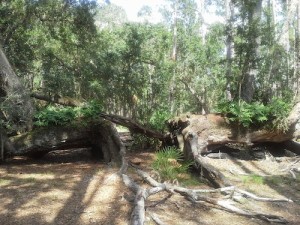
The protected area (I’ll call it that in preference to “Wildlife and Environmental Area”) is named after the Split Oak, a 200 year-old tree that was struck by lightning at one point, and continued to grow. It’s an interesting sight.

The protected area itself contains a variety of ecosystems: you enter it through a swampy wetland, and the trail passes through pine flatwoods before entering the oak forest and passing by a little lake. We didn’t explore too far on this hike, as we were meeting friends at a soccer game that evening (as you can see from Yan’s jersey).
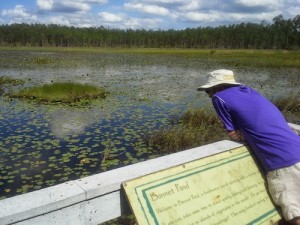
So, it was a short but interesting walk, with a variety of birds, plants, and a strikingly-colored electric turquoise-striped garter snake. Sadly, the snake slithered off before we got any good photos of it. But since my preference is for shy non-venomous snakes rather than aggressive venomous ones, I can’t really complain.
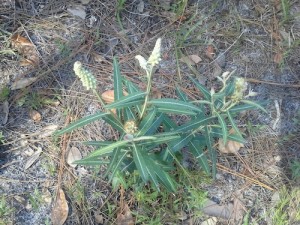
Okay, so it’s been quite a while since I’ve updated. While I have some interesting travel posts to discuss, I’ll start with a bunnyblogging post.
…In which Noe does not appear. She’s shedding right now, and looks pretty mangy as a result (not literal mange, not to worry). But she’s not her usual sleek and sparkly self.
So today, I have some photos of a rodent, which is at least similar to a rabbit. This is a squirrel who’s been climbing precariously on the outside of our patio screens for the last few weeks. It’s precarious because we’re on the third floor. While I don’t really want the little beastie clambering all over and doing who knows what, I don’t have the heart to scare it and make it fall off. So I’ve been shooing it away quietly.
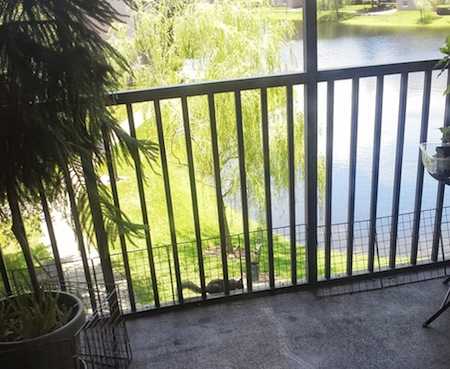
This incident was a bit of a first, because the squirrel was licking something off of the patio ledge. No idea what it was. Pretty gross.
